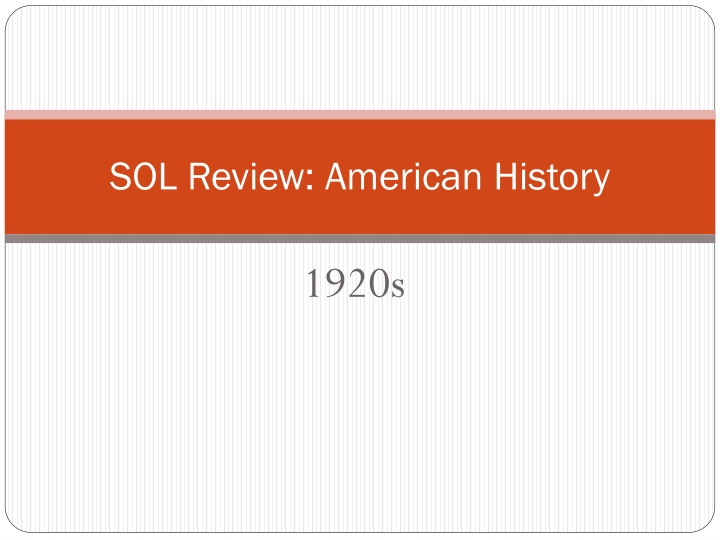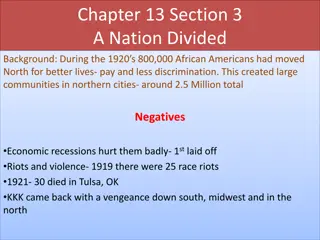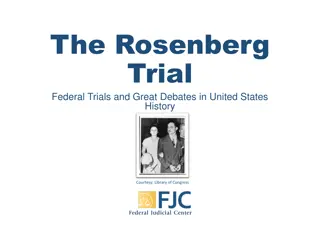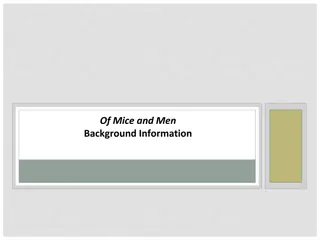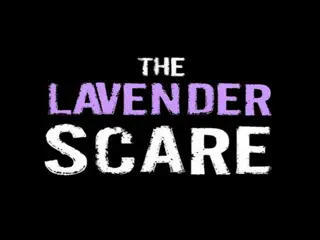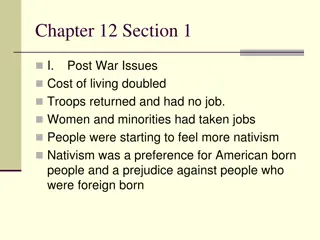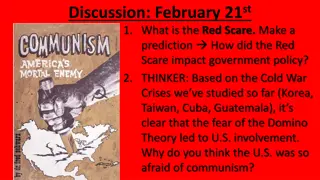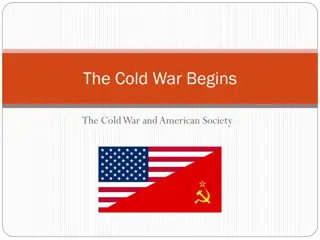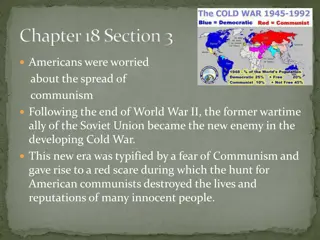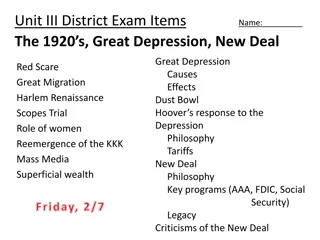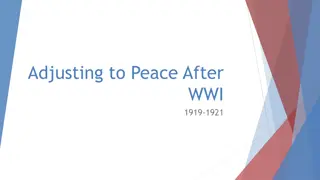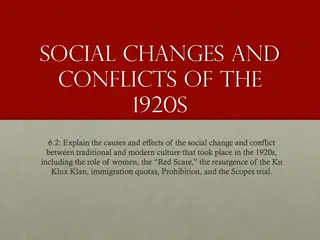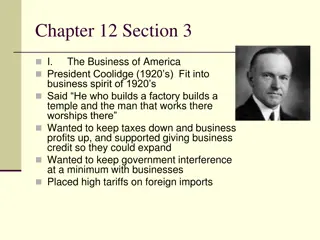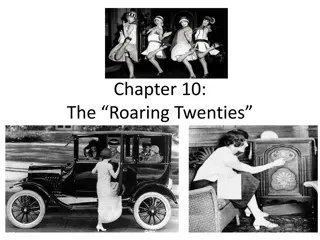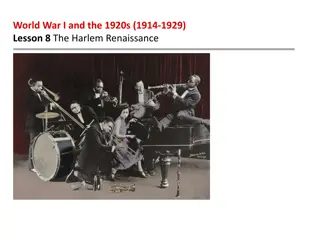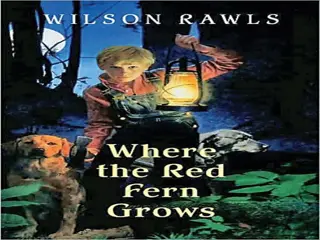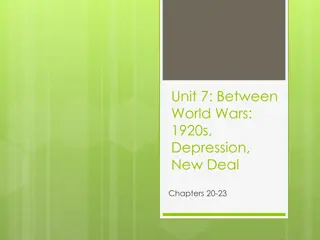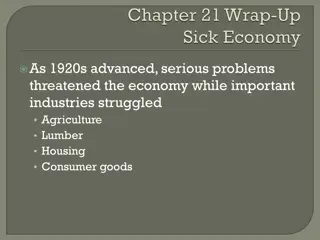American History in the 1920s: Red Scare, Prohibition, and Social Change
Explore the tumultuous period of the 1920s in American history, characterized by events such as the Red Scare, Prohibition, economic challenges, and the Harlem Renaissance. These years saw significant social and political shifts, including debates over civil rights, free speech, and government control. Understand the impact of historical events like the McCarthy Era, Sacco and Vanzetti trial, and the struggles faced by American farmers post-World War I.
Download Presentation

Please find below an Image/Link to download the presentation.
The content on the website is provided AS IS for your information and personal use only. It may not be sold, licensed, or shared on other websites without obtaining consent from the author.If you encounter any issues during the download, it is possible that the publisher has removed the file from their server.
You are allowed to download the files provided on this website for personal or commercial use, subject to the condition that they are used lawfully. All files are the property of their respective owners.
The content on the website is provided AS IS for your information and personal use only. It may not be sold, licensed, or shared on other websites without obtaining consent from the author.
E N D
Presentation Transcript
In the United States, the Red Scare of 1919 and the McCarthy Era of the early 1950 s were periods of 1. severe economic depression 2. widespread support for groups promoting international anarchy 3. great growth in art, literature, and music 4. persecution of people suspected of holding anti- American political views
Which conclusion can be drawn from the occurrence of the Red Scare and the decision of the Supreme Court in Schenck v. United States? 1. Immigrants to the United States are consistently denied equal protection under the law. 2. A person s best protection from persecution rests with the Supreme Court. 3. Civil rights are sometimes compromised by the public s fear of radical political groups 4. Violent protests in the United States are usually met with a violent response from the government.
Based on a study of the trial of Sacco and Vanzetti (1920s) and the internment of Japanese Americans (1940 s), which conclusion is most accurate? 1. The Bill of Rights is not intended to apply to naturalized citizens 2. Racial and ethnic hostilities are effectively checked by adherence to due process of law. 3. Internment of suspected criminals is necessary during wartime. 4. Nativism and racism sometimes override the ideals of constitutional democracy
After World War I, why did American farmers fail to share in the general economic growth of the United States? 1. Many immigrants were settling in the west and competing with the farmers. 2. The Federal Government reduced the number of acres on which farmers could grow subsidized crops. 3. Farmers could not produce enough to keep up with demand. 4. Overproduction and competition caused falling prices.
The Harlem Renaissance of the 1920s was a period when African Americans 1. left the United States in large numbers to settle in Nigeria 2. created noteworthy works of art and literature 3. migrated to the West in search of land and jobs 4. used civil disobedience to fight segregation in the Armed Forces
Public disregard for Prohibition and for laws prohibiting gambling indicates that 1. the American film industry has great influence on public opinion 2. the system of checks and balances does not work 3. attempts to legislate public morality may be met with strong resistance 4. American citizens have little, if any, respect for laws
United States participation in the Washington Conference (1921), in the Kellogg-Briand Pact (1928), and in the SALT talks of the 1970 s is evidence that the United States 1. has followed a free trade policy for most of the 20th century 2. relies on military alliances for defense against aggression 3. has been willing to cooperate with other nations to reduce world tensions 4. believes that cultural exchange programs are a way to promote international understanding
The 1920s are sometimes called the "Roaring Twenties" because 1. foreign trade prospered after World War I 2. the United States assumed a leadership role in world affairs 3. political reforms made government more democratic 4. widespread social and economic change occurred
Which generalization most accurately describes the literary works of Langston Hughes, Sinclair Lewis, and John Steinbeck? 1. Politics and art seldom mix well. 2. The best literature concerns the lives of the wealthy. 3. Literature often reflects the times in which it is created. 4. Traditional American themes are the most popular
What was one similarity between the Red Scare following World War I and the Cold War following World War II? 1. Fear of communism led to the suppression of the civil liberties of some Americans. 2. Large numbers of Russian revolutionaries settled in the United States. 3. Congressional investigations proved that the Federal Government was heavily infiltrated by Communist spies. 4. Renewed fighting between wartime enemies was a constant threat.
In the 1920s, the Immigration Act of 1924 and the Sacco-Vanzetti trial were typical of the 1. rejection of traditional customs and beliefs 2. acceptance of cultural differences 3. increase in nativism and intolerance 4. support of humanitarian causes
The economic boom and the financial speculation of the 1920 s were caused in part by 1. installment buying and an unregulated stock market 2. the expansion of civil rights to women and minorities 3. the mobilization of the economy for war 4. increased government restrictions on big business
After World War I, which factor was the major cause of the migration of many African Americans to the North? 1. the start of the Harlem Renaissance 2. increased job opportunities in Northern cities 3. laws passed in Northern States to end racial discrimination 4. Federal Government job-training programs
How the Other Half Lives, Jacob Riis (1890) The Jungle, Upton Sinclair (1906) The Grapes of Wrath, John Steinbeck (1939) Unsafe at Any Speed, Ralph Nader (1965) What has been the impact of these authors and their books on American society? 1. Most Americans have developed a preference for escapist and romantic literature. 2. Most American authors have adopted a conservative viewpoint 3. American business has corrected poor conditions quickly. 4. These works have had significant influence on social, political, and economic reforms.
The 1925 trial of John Scopes reflects the conflict between 1. science and religion 2. isolation and international involvement 3. traditional roles and new roles for women 4. Prohibition and organized crime
The works of Duke Ellington and Langston Hughes reflected the 1. expanding role of women in the 1920s 2. achievements of the Harlem Renaissance 3. architectural innovations of the 1930s 4. influence of southern European immigrant groups
During the 1920s, controversies concerning the Scopes trial, national Prohibition, and the behavior of flappers were all signs of disagreement over 1. the return to normalcy 2. traditional values and changing lifestyles 3. causes of the Great Depression 4. the benefits of new technology
Which pair of events illustrates an accurate cause- and-effect relationship? 1. Sacco and Vanzetti trial ---> ratification of the woman suffrage amendment 2. rebirth of the KKK ---> formation of the Populist Party 3. Red Scare ---> demand for limits on immigration 4. high food prices ---> start of the Great Depression
Public Ignores Prohibition Restrictions Evolution and Creation Debated in Scopes Trial Women Bring Change to the Industrial Workforce What do headlines such as these from the 1920s illustrate? 1. conflict between traditional and modern values 2. trend toward mass consumption of consumer goods 3. hostility of certain groups toward ethnic minorities 4. debate over the role of government in the economy
